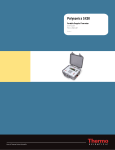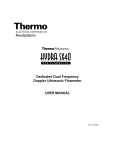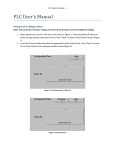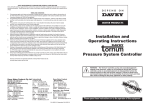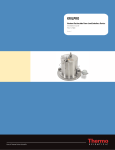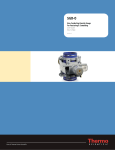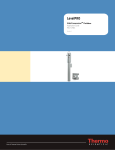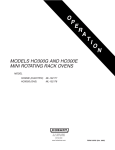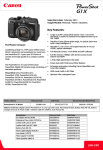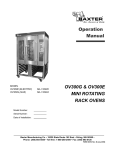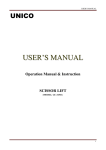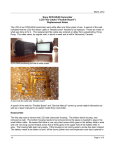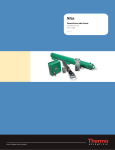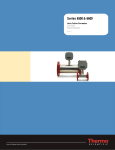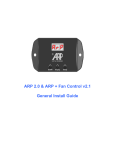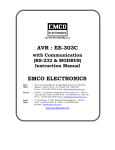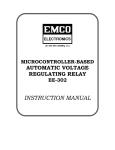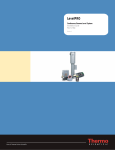Download SX40 User Guide - Fisher Scientific
Transcript
SX40 Dedicated Doppler Flowmeter User Guide P/N 1-0563-006 Revision M Part of Thermo Fisher Scientific SX40 Dedicated Doppler Flowmeter User Guide P/N 1-0563-006 Revision M © 2010 Thermo Fisher Scientific Inc. All rights reserved. “Sil-Glyde” is a registered trademark of American Grease Stick Company. All other trademarks are the property of Thermo Fisher Scientific Inc. and its subsidiaries. Thermo Fisher Scientific (Thermo Fisher) makes every effort to ensure the accuracy and completeness of this manual. However, we cannot be responsible for errors, omissions, or any loss of data as the result of errors or omissions. Thermo Fisher reserves the right to make changes to the manual or improvements to the product at any time without notice. The material in this manual is proprietary and cannot be reproduced in any form without expressed written consent from Thermo Fisher. This page intentionally left blank. Contents Thermo Fisher Scientific Chapter 1 Product Overview ............................................................................................. 1-1 Introduction........................................................................................ 1-1 Ordering Information ......................................................................... 1-1 Specifications ...................................................................................... 1-2 Performance ..................................................................................... 1-2 Physical ............................................................................................ 1-2 Functional........................................................................................ 1-3 Approvals ......................................................................................... 1-4 Chapter 2 Installation & Wiring........................................................................................ 2-1 Installing the Transducers ................................................................... 2-1 Mounting the Enclosure...................................................................... 2-4 Wiring ................................................................................................ 2-5 AC Power......................................................................................... 2-5 DC Power ........................................................................................ 2-6 Transducers..................................................................................... 2-7 Relays............................................................................................... 2-9 4–20 mA Current Loop (Rev. F or Earlier) .................................... 2-11 4–20 mA Current Loop (Rev. G or Later)...................................... 2-13 Connecting a Switch to Remote Zero Feature ................................ 2-14 Chapter 3 Operation & Configuration .............................................................................. 3-1 The Interface....................................................................................... 3-1 Screen Contrast................................................................................ 3-1 Configuration ..................................................................................... 3-2 Auto Mode....................................................................................... 3-2 Manual Mode .................................................................................. 3-3 HydraScan .......................................................................................... 3-6 Chapter 4 Setup Items......................................................................................................... 4-1 Reset ................................................................................................... 4-1 Config................................................................................................. 4-1 I/O Test .............................................................................................. 4-1 Relays............................................................................................... 4-1 4–20 mA Loop Calibration .............................................................. 4-1 4–20 mA Loop Test ......................................................................... 4-2 Flow.................................................................................................... 4-2 Rate.................................................................................................. 4-2 SX40 User Guide v Contents Max.................................................................................................. 4-2 vi SX40 User Guide Chapter 5 Flow Menu Items...............................................................................................5-1 Setup................................................................................................... 5-1 FFT..................................................................................................... 5-1 Logset ................................................................................................. 5-1 Accessing, Saving, & Loading Log Files............................................ 5-1 Trend.................................................................................................. 5-1 Rate.................................................................................................. 5-1 Max.................................................................................................. 5-2 Chapter 6 Troubleshooting & Maintenance ...................................................................6-1 General Troubleshooting .................................................................... 6-1 Learn Mode Warnings ..................................................................... 6-2 Operating Mode Warnings .............................................................. 6-2 Variable Frequency Drives (VFDs)................................................... 6-3 Checking the FFT............................................................................ 6-3 Signal Quality & Strength................................................................... 6-5 Maintenance ....................................................................................... 6-6 General ............................................................................................ 6-6 Replacing the Relays......................................................................... 6-6 Replacing the 4–20 mA Board ......................................................... 6-7 Replacing the Fuse ........................................................................... 6-8 Upgrades............................................................................................. 6-9 Contact Information ........................................................................... 6-9 Warranty........................................................................................... 6-10 Appendix A Hazardous Area Installations ........................................................................A-1 Appendix B Obtaining Pipe ID .............................................................................................B-1 Appendix C Toxic & Hazardous Substances Tables ....................................................... C-1 Thermo Fisher Scientific Chapter 1 Product Overview Introduction Thermo Fisher Scientific’s SX40 dedicated Doppler flowmeter generates two independent ultrasonic signals at different frequencies. By correlating these frequencies, the instrument automatically identifies and eliminates noise errors from sources such as variable frequency drives. In addition, operation of the instrument is enhanced by an Expert System that allows the flowmeter to automatically “learn” the application parameters. As a result, the flowmeter can be easily commissioned in a fraction of the time required to configure competitive ultrasonic flowmeters. Ordering Information Thermo Fisher Scientific Refer to the following list of part numbers to order spare parts for your instrument. Table 1–1. Part Number Description 22767-0001 Poly CD, specification sheet, meter installation video CD 1-0563-006 User guide 1-0561-005 HydraScan software manual 01008-0006 RS232 cable, standard serial, 6-ft, female to male, DB9 10241-0003 Hazardous area relay, 3 A, SPDT 10261-0013 Fuse, 1 A, time delay, AC input 10396-0194 Power cord connector, CGB, for 6 ft. AC power cord 10605-0001 Pipe strap, SS, 32-inch with 3/8 SS screw 10605-0003 Pipe strap, SS, 67-inch with 3/8 SS screw 10705-0003 Nut driver, 3/8-inch 10808-0002 Coupling compound, silicone RTV108, 2.8 oz. 10823-0005 Coupling compound, Sil-Glyde®, 4 oz. 20192-0001 SS tag 22061-0001 Heater assembly suitable for -40°F to 140°F (-40°C to 60°C) operation, 100–120 Vac SX40 User Guide 1-1 Product Overview Specifications Part Number Description 22061-0002 Heater assembly suitable for -40°F to 140°F (-40°C to 60°C) operation, 220–240 Vac 22204-0003 Mounting feet, set of 4 22262-0006 PCB assembly, 4–20 mA output (applicable with firmware v. 2.03) 22302-0002 PCB assembly, motherboard (specify input voltage) 22366-0002 Cable adapter, dedicated transducer to portable meter 22490-0001 Cable adapter set, portable transducer to dedicated meter 22511-0020 Intrinsically Safe barrier kit, universal 22686-0002 PCB assembly, Doppler 22703-0002 Transducer assembly (set of 2), 30-ft cable length 22705-0002 PCB assembly, CPU 22714-0002 PCB assembly, adapter board 22732-0001 Front panel assembly, includes keypad and display 22801-0002 PCB assembly, 4–20 mA output (applicable with firmware v. 3.03) 22061-0003 Heater assembly suitable for -40°F to 140°F (-40°C to 60°C) operation, 24 Vdc Specifications Performance Velocity Range: 0.2–18 ft./sec. (0.06–5.5 m/sec.) Accuracy: ±1% of velocity full scale Fluids: Liquids containing particulate or entrained gas bubbles Pipe Size: 0.5–200 in. (12–5000 mm) Physical Transmitter: NEMA 4X (IP65), flame retardant, fiberglass reinforced polyester Transducers Two encapsulated dual frequency sensor heads suitable for submersible/underground service Encased in stainless steel shrouds, with stainless steel straps and quick clamps Cable length: 30 ft. (9 m) Weight: 12 lb. (5.4 kg) Dimensions: Refer to Figure 1–1 1-2 SX40 User Guide Thermo Fisher Scientific Product Overview Specifications Figure 1–1. Functional Outputs: 4–20 mA (into 750 ohms), 12-bit, 5 kV opto-isolated; loop or self-powered Optional Relay: 5 A, SPDT, programmable relay; maximum of 4 Power Supply DC Power: 11–28 Vdc AC Power: 90–132 Vac or 190–250 Vac (switch selectable), 50/60 Hz Keypad: 19-key with tactile action Display: Backlit, 240 x 60 dot, high resolution graphics display Data Logger: 90000 points, programmable in intervals of 30 s, 1, 5, 15, 30, and 60 min Programming: Via HydraScan software or integral keypad Serial Interface: RS232 Thermo Fisher Scientific SX40 User Guide 1-3 Product Overview Specifications Temperature Range Transducers: -40°F to 250°F (-40°C to 121°C); coax cable limited to 176°F (80°C) Electronics: -20°F to 140°F (-29°C to 60°C) With integral heater: -40°F to 140°F (-40°C to 60°C) Approvals Hazardous Area Certification Optional: CSA Class I, Div. 2 or Class II, Div. 2 Optional: CSA Intrinsically Safe Class I, Div. 1; Class II, Div. 1; or Class III, Div. 1 Optional: Intrinsically Safe CENELEC (LCIE) 1-4 SX40 User Guide Thermo Fisher Scientific Chapter 2 Installation & Wiring Installing stalling the Transducers 1. Select an installation site: Keep the following questions in mind when choosing a proper installation site: ● Is the chosen section of pipe always full of liquid? ● Are there at least 5 pipe diameters upstream and 3 pipe diameters downstream from any directional changes, pipe joints, or narrowing/widening of the pipe? Figure 2–1. Recommended installation locations Conditions at locations A, B, C, D, and E can interfere with the transmission of the ultrasonic wave and yield inaccurate or unreliable flow readings: ● A: Pipe may not be full ● B: Down flow ● C: Too close to elbow ● D: Air collects at the top of the horizontal pipe ● E: Sediment collects at the bottom of the horizontal pipe Note Selecting the proper installation location is essential to flow measurement reliability. Each application is unique and may require a variation of installation locations. ▲ Thermo Fisher Scientific SX40 User Guide 2-1 Installation & Wiring Installing the Transducers 2. Select a transducer orientation: Refer to Figure 2–2. If your application allows, install the transducers at the 3 and 9 o’clock locations. Ensure the transducers are parallel to each other along the pipe circumference. Figure 2–2. Recommended transducer orientations 3. Attach the transducers to the pipe strap: a. Use a screwdriver to loosen the mounting screw and slide the lock back on each transducer. Figure 2–3. 2-2 SX40 User Guide Thermo Fisher Scientific Installation & Wiring Installing the Transducers b. Place the pipe strap across the mounting, and slide the lock back into place. Figure 2–4. c. Tighten the screws. Figure 2–5. 4. Mount the transducers, ensuring the transducers face the same direction (as shown in Figure 2–6): a. Wrap the pipe strap around the pipe, and slide the end of the pipe strap through the tension nut assembly. b. Pull the strap tightly, and clamp the tension nut down to secure the strap to the pipe. c. Loosen the mounting screw of a transducer, and move the transducer to the 3 o’clock position on the pipe. Tighten the mounting screw to secure the transducer. d. Loosen the mounting screw of the second transducer, and move the transducer to the 9 o’clock position. Tighten the mounting screw to secure the transducer. e. Remove the strap from the pipe, and apply sonic coupling compound to each transducer surface. f. Reposition the strap on the pipe, placing the transducers in the proper positions. Thermo Fisher Scientific SX40 User Guide 2-3 Installation & Wiring Mounting the Enclosure g. Tighten the tension nut assembly with a 3/8-inch hex nut driver to secure the strap. Note Increasing the pipe strap tension improves signal transmission. ▲ Figure 2–6. Mounting ounting the Enclosure Warning To prevent the possibility of electrical shock and/or damage to the meter, do not mount the enclosure where it can be submerged or partially submerged. ▲ 1. Locate a sturdy, vertical mounting surface. 2. Remove the meter access cover, and locate the 4 mounting holes (1 in each corner of the cover). 3. Attach the enclosure to the wall using the mounting screws. 4. Replace the meter access cover. Note An optional mounting ear package is also available. ▲ 2-4 SX40 User Guide Thermo Fisher Scientific Installation & Wiring Wiring Wiring AC C Power Warning Prevent possible electrical shock and/or damage to the meter: Disconnect power to the meter PRIOR TO wiring. ▲ Caution Connecting AC power to a DC power meter may damage the meter. ▲ Note CE certifications require that a switch or circuit breaker be installed in close proximity to the instrument and be labeled as the instrument disconnect. ▲ Refer to the following instructions and Figure 2–7 when wiring the instrument for AC power. 1. Remove the meter access cover. 2. Locate the AC input voltage selector, and turn the switch to 110 or 220 V to match the power line voltage. 3. Locate the L1, L2/N, and GND connections within power input block. 4. Turn the terminal screws on top of the input block counterclockwise to fully open the wire connections. 5. Make the following connections: a. Ground wire to GND (CE certification requires less than 1 ohm between terminal and ground) b. Hot wire to L1 c. If the input voltage is 110 V, neutral wire to L2/N d. If the input voltage is 220 V, second hot wire to L2/N 6. Turn the terminal screws clockwise to close them connections. 7. Ensure the wires are securely connected to the input block, and replace the meter access cover. Thermo Fisher Scientific SX40 User Guide 2-5 Installation & Wiring Wiring Figure 2–7. AC power connections DC Power Later versions of the instrument (those with P/N 22302-0002 Rev. G and later) have DC operation built into the instrument. Refer to the following instructions and Figure 2–8. 1. Remove the meter access cover. 2. Locate the power input block, and turn the terminal screws on top of the input block counterclockwise to fully open the wire connections. 3. Make the following connections: a. +24VDC to P2 +24 b. 24 VDC return to either of the P2 GND connections 4. Turn the terminal screws clockwise to close them connections. 2-6 SX40 User Guide Thermo Fisher Scientific Installation & Wiring Wiring 5. Ensure the wires are securely connected to the input block, and replace the meter access cover. Figure 2–8. DC power connections Transducers Warning Prevent possible electrical shock and/or damage to the meter: Disconnect power to the meter PRIOR TO wiring. ▲ 1. Refer to Figures 2–9 and 2–10. 2. Remove the meter access cover. 3. Remove the nut from the transducer cable connector, and draw the cable through the opening in the meter enclosure. 4. Thread the nut onto the cable connector to the inside of the enclosure. Thermo Fisher Scientific SX40 User Guide 2-7 Installation & Wiring Wiring 5. Tighten the nut to 15 ft-lb of torque using a torque wrench. 6. Locate the XMT (DN), XMTGND, RCV (UP), and RCVGND wire connections within the transducer I/F block. 7. Turn the screws on top of the transducer block counterclockwise to fully open the connections. 8. Identify the transducer’s 2 signal wires and 2 braided ground wires. 9. Make the following connections: a. First signal wire to XMT (DN) b. First braided ground wire to XMT GND c. Second signal wire to RCV (UP) d. Second braided ground wire to RCV GND 10. Turn each screw clockwise to close the connections. 11. Ensure the wire connections are secure, and replace the meter access cover. Figure 2–9. Transducer cable seal assembly 2-8 SX40 User Guide Thermo Fisher Scientific Installation & Wiring Wiring Figure 2–10. Transducer connections Relays elays Warning Prevent possible electrical shock and/or damage to the meter: Disconnect power to the meter PRIOR TO wiring. ▲ Refer to step 10 of “Manual Mode” in Chapter 2 for instructions on relay configuration. 1. Refer to Figures 2–11 and 2–12. 2. Remove the meter access cover. 3. Locate the 4 relay terminals blocks, and select the relay you are going to wire. 4. Locate the Normally Closed (NC), Common (C), and Normally Open (NO) relay contacts on the terminal block. Thermo Fisher Scientific SX40 User Guide 2-9 Installation & Wiring Wiring Note When the relay is at rest, the circuit is closed between the NC and C terminals and open between the NO and C terminals. When the relay is energized, the circuit is open between the NC and C terminals and closed between the NO and C terminals. ▲ 5. Turn the terminal screw on top of each connection counterclockwise to fully open the connections. 6. Insert the wires for your control system into the corresponding wire connections. 7. Turn the terminal screws clockwise to close the connections. 8. Ensure the wire connections are secure, and test the relay (see “I/O Test” in Chapter 4). 9. Replace the meter access cover. Figure 2–11. Relay schematic 2-10 SX40 User Guide Thermo Fisher Scientific Installation & Wiring Wiring Figure 2–12. Relays & relay terminal connections 4–20 mA Current Loop (Rev. F or Earlier) Warning Prevent possible electrical shock and/or damage to the meter: Disconnect power to the meter PRIOR TO wiring. ▲ Warning Use shielded twisted pair wires for this connection. If the meter is installed near VFDs, install wiring in grounded metal conduit. ▲ Note These instructions for instruments with main PCB 22302-0002 Rev. F or earlier. ▲ For instructions on performing a 4–20 mA calibration and/or test, refer to “I/O Test” in Chapter 4. Thermo Fisher Scientific SX40 User Guide 2-11 Installation & Wiring Wiring 1. Refer to Figures 2–13 and 2–14. Select a power option for the 4–20 mA loop, and remove the meter access cover. 2. Use jumpers to configure the pins on the 4–20 mA card according to the power option selection. 3. Connect the wiring to the module. 4. Replace the access cover. Figure 2–13. Self-powered current loop & pin configuration Figure 2–14. Externally powered current loop & pin configuration 2-12 SX40 User Guide Thermo Fisher Scientific Installation & Wiring Wiring 4–20 mA Current Loop (Rev. G or Later) Warning Prevent possible electrical shock and/or damage to the meter: Disconnect power to the meter PRIOR TO wiring. ▲ Warning Use shielded twisted pair wires for this connection. If the meter is installed near VFDs, install wiring in grounded metal conduit. ▲ Note These instructions for instruments with main PCB 22302-0002 Rev. G or later. ▲ For instructions on performing a 4–20 mA calibration and/or test, refer to “I/O Test” in Chapter 4. 1. Refer to Figures 2–15 and 2–16. Select a power option for the 4–20 mA loop, and remove the meter access cover. 2. Use jumpers to configure the pins on the 4–20 mA card according to the power option selection. 3. Connect the wiring to the module. 4. Replace the access cover. Figure 2–15. Self-powered current loop Thermo Fisher Scientific SX40 User Guide 2-13 Installation & Wiring Wiring Figure 2–16. Externally powered current loop Connecting necting a Switch to Remote Zero Feature Warning Prevent possible electrical shock and/or damage to the meter: Disconnect power to the meter PRIOR TO wiring. ▲ Refer to step 9 in “Manual Mode” (Chapter 3) for instructions on enabling the remote zero function. 1. Refer to Figure 2–17. 2. Remove the meter access cover. 3. Locate the POSZERO and RLYCOM wire connections within the same block used for connecting DC power. 4. Turn the screws on top of the transducer block counterclockwise to fully open the connections. 5. Make the following connections: a. First switch wire to RLYCOM b. Second switch wire to POSZERO 2-14 SX40 User Guide Thermo Fisher Scientific Installation & Wiring Wiring 6. Turn the screws clockwise to close the connections. 7. Ensure the wire connections are secure, and replace the meter access cover. Figure 2–17. Remote zero connections Thermo Fisher Scientific SX40 User Guide 2-15 This page intentionally left blank. Chapter 3 Operation & Configuration The Interface Figure 3–1. Keypad features Following is a description of the components called out in Figure 3–1. Screen Contrast ● LCD: Displays menu items. ● Scroll: Press to scroll to the next parameter displayed on the LCD ● Enter: Press once you have made an entry. ● Backspace: Deletes the last value entered. ● Numeric keys: Use to enter values when configuring the meter ● Menu selection keys: Press to select the corresponding menu item displayed on the LCD 1. Press the +/- key. 2. When the Adjust Contrast screen appears, press the +/- key again, and the software scrolls through the levels of contrast. Press the +/- key to stop the scrolling. 3. Use the scroll and backspace keys to make fine adjustments to the contrast. Thermo Fisher Scientific SX40 User Guide 3-1 Operation & Configuration Configuration Configuration Note the following before configuring the meter: ● You must know the pipe internal diameter (ID) to ensure reliable flow measurements. If you do not know the pipe ID, go to Appendix B. ● There must be flow in the pipe when you start the meter. There are two modes of operation. Consider using auto mode if your application is a constant process. The instrument default is the auto mode. Apply power to the meter, and begin the configuration process by selecting Auto or Manual operating mode. Once you have completed the configuration process, you can access these screens from the Flow screen by selecting Setup > Config. Auto Mode 1. Pipe ID screen: a. Enter the pipe ID, and press Enter. b. Use the scroll key to select the measurement units (inches, mm). Press Enter to select the unit. c. Scroll through the available wall material options (carbon steel, cast iron, concrete liner, stainless steel, copper, plastic), and press Enter to select. 2. Select Next to move to the next screen. At the Flow Units screen: d. Use the scroll key to select the flow units (US gallons, million gallons, cubic meters, oil barrels, Imperial gallons, cubic feet, liters, liquid barrels), and press Enter. e. Use the scroll key to select the time base for flow measurement (seconds, minutes, hours, days), and press Enter. 3. Select Next to enter learn mode. 4. The meter displays status of the learning process. Refer to “Learn Mode Warnings” (Table 6–2 in Chapter 6) if you receive one of the following messages: 3-2 SX40 User Guide ● Invalid Signal, Can’t Learn ● No Flow, Can’t Learn ● Warning Low S Strength ● Warning Poor S Strength Thermo Fisher Scientific Operation & Configuration Configuration 5. Once the meter completes the learning process, the Flow screen appears. a. If the flow reading is not accurate and you can verify the flow from a calibrated flowmeter or other certified source, perform a calibration. b. Refer to “Operating Mode Warnings” (Table 6–3 in Chapter 6) if the meter displays any of the following warnings: Manual Mode ● Warning ● Alarm ● Failed/No Flow 1. Pipe ID screen: a. Enter the pipe ID, and press Enter. b. Use the scroll key to select the measurement units (inches, mm). Press Enter to select the unit. c. Scroll through the available wall material options (carbon steel, cast iron, concrete liner, stainless steel, copper, plastic), and press Enter to select. 2. Select Next to move to the next screen. At the Flow Units screen: a. Use the scroll key to select the flow units (US gallons, million gallons, cubic meters, oil barrels, Imperial gallons, cubic feet, liters, liquid barrels), and press Enter. b. Use the scroll key to select the time base for flow measurement (seconds, minutes, hours, days), and press Enter. 3. Select Next to continue, and enter the Maximum Flow Rate. 4. Select Next. At this screen: a. Scroll through the options available for the Velocity Range (2, 4, 8, 16, 32 ft/s) and press Enter to select. Scroll to the next parameter. b. Enter a damping coefficient (0–99, 1 unit = 15 s). The damping coefficient suppresses short term fluctuations in the indicated flow rate. Increasing the coefficient increases the response time to changes. Keep damping at a minimum unless the flow rate fluctuates wildly. In this case, increase damping just enough to reduce the fluctuation to an acceptable degree. Press Enter, and scroll to the next parameter. Thermo Fisher Scientific SX40 User Guide 3-3 Operation & Configuration Configuration Note The Smart Filter used by the meter allows the damping function to smooth small fluctuations without diminishing the meter’s response to large flow changes, even when configured with a high damping coefficient. ▲ c. Select regular or high Transmit Power, and press Enter. In applications where the signal strength is low, the meter automatically selects high transmit power. You can manually select regular or high power in applications where the signal strength is marginal or where you feel increased or decreased power output may improve signal quality. 5. At the next screen: a. Enter the low flow cutoff. Press Enter, and scroll to the next parameter. When a zero flow condition occurs, internal sloshing and other fluid movement can prevent the flowmeter from reading total zero. This can result in totalizer errors. Minimize these errors by setting a low flow cutoff which drives the flowmeter to zero for flow rates at or below specified value. b. Enter the signal strength cutoff, and press Enter. 6. Select Next to continue. At this screen: a. Enter the signal quality cutoff, and press Enter. b. Enter the SNR (signal-to-noise ratio), and press Enter. 7. Select Next. This screen displays flow and velocity readings. You can also enter a site calibration factor: a. Determine the flow using another source, and calculate the site calibration adjustment by dividing the actual flow by the meter flow. b. Enter the site calibration adjustment. 8. Select Next. At this screen: a. Scroll to the required totalizer unit (US gallons, Imperial gallons, million gallons, cubic feet, cubic meters, liters, oil barrels, liquid barrels) and press Enter. b. Scroll through the available scale factors (x 1, 10, 100, 1000, 10000), and press Enter to select. 3-4 SX40 User Guide Thermo Fisher Scientific Operation & Configuration Configuration c. Determine whether to reset the totalizer and scroll to the appropriate selection. Press Enter. 9. Select Next. At this screen: a. To keep relay 1 as the pulse totalizer, scroll to and select x1. b. To keep relay 4 as the lost power monitor, select Y. c. To enable the remote zero feature, scroll to On. The lost power feature is designed to trigger a warning signal (alarm or warning light) when the meter looses power and is no longer reading flow. The meter records the number of power losses, and relay 4 is the dedicated lost power relay. For example, a warning light in a control room that is powered by an independent source can indicate when the meter looses power. This feature is ideal for applications where flowmeter operation is critical. d. Reset the power monitor by selecting Yes. 10. Select Next. The next four screens enable you to configure the relays. Determine which relay you want to configure, and move to that screen. a. Determine the maximum allowable flow. If you want the relay to energize when flow is greater than maximum acceptable flow, select On. If the relay should de-energize, select Off. b. Enter the maximum and minimum allowable flows in the corresponding text boxes. c. Activate the relay and press Enter. 11. Select Next to continue. Set the range at this screen: a. Enter the flow rate that equals the 4 mA (minimum) reading, and press Enter. b. Enter the flow rate that equals the 20 mA (maximum) reading, and press Enter. 12. Select Next, and if a password is required, enter it here. 13. Select Next to move to the final setup screen. 14. Set the time and date at this screen, and press Next to complete the configuration process. Thermo Fisher Scientific SX40 User Guide 3-5 Operation & Configuration HydraScan HydraScan 3-6 SX40 User Guide You can also use the HydraScan software to configure the instrument. Refer to the HydraScan user guide (P/N 1-0563-005). Thermo Fisher Scientific Chapter 4 Setup Items You can access the Setup menu from the main Flow screen. The Setup menu displays the instrument version and serial number. It also contains 3 submenus: Reset, Config, and I/O Tst. Reset Config Select this item to reset all configuration parameters to defaults. Refer to Chapter 3 for details on setting configuration parameters. Each parameter is discussed in the section “Manual Mode.” I/O Test Relays Access this screen to test the relays. Relays do not have to be configured in order for you to test them. Note Exiting this screen returns all relays to the OFF positions. Activate the relays according to step 10 of “Manual Mode” in Chapter 3. ▲ At the Relay Test screen, scroll to the relay you want to test. Press Enter to switch the relay on (energize), and press Enter again to switch the relay off (de-energize). 4–20 mA Loop Calibration Note You will need a calibrated current meter to perform this procedure. If you are using the loop-powered configuration, you will also need a DC power source. ▲ For wiring instructions, refer to Chapter 2. 1. Set up a calibration current loop. Thermo Fisher Scientific SX40 User Guide 4-1 Setup Items Flow 2. Access the mA Cal screen, and enter the value in mA from the current meter that corresponds to the zero scale. 3. Press Enter. 4. Enter the value in mA from the current meter that corresponds to the full scale. 5. Press Enter, and continue to the next section to test the loop. 4–20 mA Loop Test For wiring instructions, refer to Chapter 2. Access the mA Tst screen. Use the scroll and backspace keys to move the current bar. Verify the meter follows the changes. If the meter does not follow the changes, repeat the calibration. Flow Flow menu items are covered in the following chapter. Trend runs at a real-time rate of action. To view the flow trend, select Trend from the Flow menu. Rate From the Trend screen, select Rate. Scroll through the available rate options (0.1, 0.5, 1, 5, 15, 60 minutes/reading). Press Enter. Max The meter records the maximum flow, date, and time of the maximum flow since the last reset. You can view this information from the Max screen. Reset the data by changing the Max field selection from “Set” to “Clear.” 4-2 SX40 User Guide Thermo Fisher Scientific Chapter 5 Flow Menu Items Setup FFT Logset Setup menu items are covered in the previous chapter. Refer to “Checking the FFT” in Chapter 6. To set up the data logging function using the instrument: 1. Select LogSet from the Flow screen. 2. The screen displays the number log points remaining. Select the log rate (intervals of 0.5, 1, 5, 15, or 60 minutes) and press Enter. 3. Turn the logger on. 4. Select Flow to return to the Flow screen. Note You cannot select the file in which you want to store a specific log set. The meter saves the data in sequenced files (0 to 9). The meter advances to the next file each time the logger is turned on or when a file logs more than 9000 points. ▲ Accessing, Saving, & Loading Log Files Trend Rate ate Thermo Fisher Scientific You can use HydraScan to download, save, load, and erase log files. Refer to the HydraScan user manual (1-0563-005). Trend runs at a real-time rate of action. To view the flow trend, select Trend from the Flow menu. From the Trend screen, select Rate. Scroll through the available rate options (0.1, 0.5, 1, 5, 15, 60 minutes/reading). Press Enter. SX40 User Guide 5-1 Flow Menu Items Trend Max The meter records the maximum flow, date, and time of the maximum flow since the last reset. You can view this information from the Max screen. Reset the data by changing the Max field selection from “Set” to “Clear.” 5-2 SX40 User Guide Thermo Fisher Scientific Chapter 6 Troubleshooting & Maintenance General Troubleshooting The instrument has 4 modes of operation: ● Setup ● Learn ● Operating ● Manual (used by factory trained personnel primarily for application troubleshooting) Use the following table in conjunction with the learn mode and operating mode warning tables. Table 6–1. Action codes Thermo Fisher Scientific Action Description A 1. Turn meter off. 2. Apply more compound. 3. Tighten the pipe strap. 4. Restart the meter to see if warning clears. B 1. Reposition transducers. 2. See if signal strength increases. 3. See if warning clears. 4. Restart the meter. C 1. Relocate transducers. 2. See if signal strength increases. 3. See if warning clears. 4. Restart meter. D 1. Turn meter off, and remove the transducers. 2. Grind the pipe surface if it is rough or coated. 3. Remount the transducers. 4. Restart the meter. See if warning clears. SX40 User Guide 6-1 Troubleshooting & Maintenance General Troubleshooting Learn Mode Warnings The following table describes the learn mode warnings and appropriate corrective actions. Complete the corrective actions in the order presented. Table 6–2. Learn mode warnings & corrective actions Operating Mode Warnings 6-2 SX40 User Guide Warning Corrective Action Invalid Signal, Can’t Learn 1. Refer to Table 6–1 and complete actions A–D, checking the meter after performing each action to see if the problem was corrected. 2. Contact Thermo Fisher. No Flow, Can’t Learn 1. Check for flowing fluid. 2. Make sure the pipe is full. 3. Check connections. 4. Restart meter. See if warning clears. 5. Contact Thermo Fisher. Warning Low S Strength 1. Turn meter off. 2. Refer to Table 6–1 and complete actions A–D, checking the meter after performing each action to see if the problem was corrected. 3. Contact Thermo Fisher. Warning Poor S Quality 1. Go into operating mode. 2. Check the FFT. Table 6–3. Operating mode warnings & corrective actions Warning Corrective Action PQ – Poor Signal Quality 1. Check the FFT. 2. Refer to Table 6–1 and complete actions B–D, checking the meter after performing each action to see if the problem was corrected. 3. Contact Thermo Fisher. FS – Failed Signal Status 1. Refer to Table 6–1 and complete actions B–D, checking the meter after performing each action to see if the problem was corrected. 2. Check the FFT. 3. Contact Thermo Fisher. IS – Invalid Signal 1. Check the FFT. 2. Contact Thermo Fisher. Thermo Fisher Scientific Troubleshooting & Maintenance General Troubleshooting Variable Frequency Drives (VFDs) Doppler flowmeters are often used in installations which use VFDs. VFDs can cause significant noise, EMI, and voltage spikes. If there are spikes on the 4–20 mA signal line while the displayed flow rate is stable, there are two actions you can take. Both actions may be required in order to resolve the problem: 1. Disconnect the 4–20 mA loop wiring and connect an ammeter with short wires directly to the 4–20 mA terminal block. Monitor the meter to see if the spikes are reduced. Installing a twisted pair shielded loop wiring in grounded metal conduit may be required. 2. Disconnect power wiring from the meter and connect to an uninterruptible power supply which is not connected to the facility wiring. Monitor the 4–20 mA output to see if the spikes are reduced. Installing the power mains in grounded metal conduit may be required. Checking the FFT 1. From the Flow screen, select FFT. 2. Refer to Figures 6–1 through 6–6 to determine the FFT condition. 3. Refer to the table below to determine the corrective action. 4. Return to the Flow screen. Table 6–4. Thermo Fisher Scientific FFT Shape Possible Cause Corrective Action Ideal Doppler N/A 1. Restart the meter. Broadband noise Poor pipe coupling or multiple noise generators 1. Refer to Table 6–1 and complete action codes A-D, checking the meter after performing each action to see if the problem was corrected. 2. Relocate transducers. 3. Turn off source of noise. Steady noise spike Electromagnetic noise 1. Turn off source of noise. 2. Relocate transducers. Fluctuating Doppler Constantly changing flow or noise 1. Increase damping (reference “Configuration” in chapter 3). 2. Relocate transducers. No Doppler reflection I or II Ultrasound signal not transmitting 1. Refer to Table 6–1 and complete action codes A-D, checking the meter after performing each action to see if the problem was corrected. SX40 User Guide 6-3 Troubleshooting & Maintenance General Troubleshooting Figure 6–1. Ideal Doppler shape Figure 6–2. Broadband noise Figure 6–3. Steady noise spike with Doppler Figure 6–4. Fluctuating Doppler profile 6-4 SX40 User Guide Thermo Fisher Scientific Troubleshooting & Maintenance Signal Quality & Strength Figure 6–5. No Doppler reflection I Figure 6–6. No Doppler reflection II Signal Quality & Strength Signal quality and signal strength are indicators of how well suited an application is for a Doppler flowmeter. To determine the quality of your application, go to the Flow screen. Note the %SS and SQ numbers in the bottom right corner. Refer to the following figure to determine the quality of the application. Also refer to Table 6–1 for actions you can take to attempt to improve signal quality and strength. Figure 6–7. Thermo Fisher Scientific SX40 User Guide 6-5 Troubleshooting & Maintenance Maintenance Maintenance General The instrument is easy to maintain. The transducers and flowmeter are factory service only components and maintenance free. The following table describes the instrument components, appropriate maintenance, and a recommended schedule. Table 6–5. Suggested maintenance Component Maintenance How Often Transducers None: Factory service item N/A Coupling compound Add more compound. Annually, or whenever: 1. Compound diminishes 2. Repositioning transducers. 3. Relocating meter. Flowmeter None: Factory service item. N/A Cable connections Ensure connections are secure. Remove any buildup within the connections. Complete as part of your facility’s routine maintenance. Replacing eplacing the Relays Warning Prevent possible electrical shock and/or damage to the meter: Disconnect power to the meter PRIOR TO wiring. ▲ 1. Disconnect the power, externally if possible. 2. Remove the meter access cover. 3. Locate the relay sockets (reference Figure 2–11), and remove the relay. 4. Push the replacement relay into the socket until it is secure. 5. Replace the access cover. 6-6 SX40 User Guide Thermo Fisher Scientific Troubleshooting & Maintenance Maintenance Replacing placing the 4–20 mA Board Warning Prevent possible electrical shock and/or damage to the meter: Disconnect power to the meter PRIOR TO wiring. ▲ 1. Remove the meter access cover. 2. Locate the 4–20 mA board (reference Figure 6–8) and disconnect the wiring to the current loop module. 3. Remove the 2 screws in the lower corners of the module, and lift the module straight out to prevent damage to the connector on the main board. 4. Align the pins on the replacement module with the connector on the main board. 5. Press the module straight in toward the board. 6. Ensure the screw holes in the mounting posts on the main board align exactly with the screw holes in the module, and replace the screws. 7. Wire and configure the 4–20 mA loop (reference Chapter 2). 8. Reconnect power, and calibrate the current loop according to “4–20 mA Loop Calibration” in Chapter 4. 9. Replace the access cover. Thermo Fisher Scientific SX40 User Guide 6-7 Troubleshooting & Maintenance Maintenance Figure 6–8. Locations of 4-20 mA board & fuse Replacing eplacing the Fuse Warning Prevent possible electrical shock and/or damage to the meter: Disconnect power to the meter PRIOR TO wiring. ▲ 1. Locate the hole in the meter access cover marked FUSE, or remove the access cover and locate the fuse holder (shown in Figure 6–8). 2. Use a small, flat blade screwdriver to depress and turn the fuse holder counterclockwise until the holder pops up. 3. Insert a similar fuse of the same rating (see Figure 6–9). 4. Replace the fuse holder. Depress and turn the holder clockwise until it locks in place. 5. Replace the access cover if removed. 6-8 SX40 User Guide Thermo Fisher Scientific Troubleshooting & Maintenance Upgrades Figure 6–9. Fuse access hole label Upgrades Contact Information The most current software is installed in the instrument prior to shipment. You can use the RS232 port and a remote terminal to upgrade the software as newer versions become available. Contact Thermo Fisher to obtain the most recent versions of the following software: ● WinLoader (used to upgrade meter software) ● Meter software ● HydraScan (data logging software) The local representative is the first contact for support and is well equipped to answer questions and provide application assistance. Your representative also has access to product information and current software revisions. You can also contact Thermo Fisher directly. Process Instruments 14 Gormley Industrial Avenue Gormley, Ontario L0H 1G0 CANADA Unit 702-715, 7/F Tower West Yonghe Plaza No. 28 Andingmen East Street, Beijing 100007 CHINA +1 (800) 437-7979 +1 (713) 272-0404 direct +1 (713) 4573 fax +1 (905) 888-8808 +1 (905) 888-8828 fax +86 (10) 8419-3588 +86 (10) 8419-3580 fax A-101, 1CC Trade Tower Senapati Bapat Road Pune 411 016 Maharashtra, INDIA Ion Path, Road Three Winsford, Cheshire CW7 3GA UNITED KINGDOM 1410 Gillingham Lane Sugar Land, TX 77478 USA +91 (20) 6626 7000 +91 (20) 6626 7001 fax +44 (0) 1606 548700 +44 (0) 1606 548711 fax www.thermoscientific.com Thermo Fisher Scientific SX40 User Guide 6-9 Troubleshooting & Maintenance Warranty If it becomes necessary to return an instrument: 1. Contact Thermo Fisher for a Return Material Authorization (RMA) number. You must have the RMA number to return an instrument. The receiving dock will not accept shipments without the RMA number. 2. Ensure the instrument is well packed, in its original shipping box if available. 3. Include a letter fully explaining the symptoms of the failure as well as detail describing the application where the unit was being operated. Also include a contact name, phone number, and purchase order authorizing repairs. 4. Write the RMA number on the outside of the shipping box. 5. Send the unit freight-paid to the address above. Warranty Thermo Scientific products are warranted to be free from defects in material and workmanship at the time of shipment and for one year thereafter. Any claimed defects in Thermo Scientific products must be reported within the warranty period. Thermo Fisher shall have the right to inspect such products at Buyer’s plant or to require Buyer to return such products to Thermo Fisher plant. In the event Thermo Fisher requests return of its products, Buyer shall ship with transportation charges paid by the Buyer to Thermo Fisher plant. Shipment of repaired or replacement goods from Thermo Fisher plant shall be F.O.B. Thermo Fisher plant. A quotation of proposed work will be sent to the customer. Thermo Fisher shall be liable only to replace or repair, at its option, free of charge, products which are found by Thermo Fisher to be defective in material or workmanship, and which are reported to Thermo Fisher within the warranty period as provided above. This right to replacement shall be Buyer’s exclusive remedy against Thermo Fisher. Thermo Fisher shall not be liable for labor charges or other losses or damages of any kind or description, including but not limited to, incidental, special or consequential damages caused by defective products. This warranty shall be void if recommendations provided by Thermo Fisher or its Sales Representatives are not followed concerning methods of operation, usage and storage or exposure to harsh conditions. 6-10 SX40 User Guide Thermo Fisher Scientific Troubleshooting & Maintenance Warranty Materials and/or products furnished to Thermo Fisher by other suppliers shall carry no warranty except such suppliers’ warranties as to materials and workmanship. Thermo Fisher disclaims all warranties, expressed or implied, with respect to such products. EXCEPT AS OTHERWISE AGREED TO IN WRITING BY Thermo Fisher, THE WARRANTIES GIVEN ABOVE ARE IN LIEU OF ALL OTHER WARRANTIES, EXPRESSED OR IMPLIED, AND Thermo Fisher HEREBY DISCLAIMS ALL OTHER WARRANTIES, INCLUDING THOSE OF MERCHANTABILITY AND FITNESS FOR PURPOSE. Thermo Fisher Scientific SX40 User Guide 6-11 This page intentionally left blank. Appendix A Hazardous Area Installations Figure A–1. Hazardous area installation with barriers Thermo Fisher Scientific SX40 User Guide A-1 Hazardous Area Installations Figure A–2. Hazardous area installation without barriers A-2 SX40 User Guide Thermo Fisher Scientific Appendix B Obtaining Pipe ID If you do not know the pipe ID, try to get pipe OD using one of the following methods: ● Read the pipe OD and schedule on the pipe. ● Read the OD and schedule from system drawings. ● Use a tape measure to measure the pipe circumference and divide the measured circumference by 3.14. ● Use Thermo Fisher’s Ultrasonic pipe Thickness Gauge (P/N 0704/0187), and perform the following calculation: Pipe ID = Pipe OD – (2 x Pipe Thickness). Table B–1. Steel, stainless steel, & PVC pipe standard schedules1 Nominal Pipe Size OD Sch. 5 Sch. 10 (light wall) 1 1.25 1.5 2 2.5 1.315 1.660 1.900 2.375 2.875 1.185 1.530 1.770 2.245 2.709 1.097 1.442 1.682 2.157 2.635 1.049 1.380 1.610 2.067 2.469 3 3.5 4 5 6 3.500 4.000 4.500 5.563 6.625 3.334 3.834 4.334 5.345 6.407 3.260 3.760 4.260 5.295 6.357 3.068 3.548 4.026 5.047 6.065 8 10 12 14 16 8.625 10.750 12.750 14.000 16.000 8.407 10.482 12.438 15.670 8.329 10.420 12.390 13.500 15.500 8.125 10.250 12.250 13.376 15.376 8.071 10.136 12.090 13.250 15.250 7.981 10.020 11.938 13.124 15.000 7.813 9.750 11.626 12.812 14.688 7.625 9.562 11.374 12.500 14.312 7.437 9.312 11.062 12.124 13.938 7.187 9.062 10.750 11.876 13.562 18 20 24 18.000 20.000 24.000 17.670 19.634 23.564 17.500 19.500 23.500 17.376 19.250 23.250 17.124 19.000 22.876 16.876 18.812 22.624 16.500 18.376 22.062 16.124 17.938 21.562 15.688 17.438 20.938 15.255 17.000 20.376 Thermo Fisher Scientific Sch. 20 Sch. 30 Sch. 40 Sch. 60 Sch. 80 Sch. 100 Sch. 120 Sch. 140 Sch. 160 Std. Wall XSTG 0.957 1.278 1.500 1.939 2.323 0.815 1.160 1.338 1.687 2.125 1.049 1.380 1.610 2.067 2.469 0.957 1.278 1.500 1.939 2.323 2.900 3.364 3.826 4.813 5.761 2.624 3.438 4.313 5.187 3.068 3.548 4.026 5.047 6.065 2.900 3.364 3.826 4.813 5.761 7.001 8.750 10.500 11.500 13.124 6.813 8.500 10.126 11.188 12.812 7.981 10.020 12.000 13.250 15.250 7.625 9.750 11.750 13.000 15.000 14.876 16.500 19.876 14.438 16.062 19.312 17.250 19.250 23.250 17.000 19.000 23.000 3.624 4.563 5.501 SX40 User Guide B-1 Obtaining Pipe ID 1 Nominal Pipe Size OD Sch. 5 Sch. 10 (light wall) Sch. 20 Sch. 30 Sch. 40 30 36 30.000 36.000 29.500 29.376 35.376 29.000 35.000 28.750 34.750 28.500 34.500 42 48 42.000 48.000 41.000 40.750 40.500 47.250 Sch. 60 Sch. 80 Sch. 100 Sch. 120 Sch. 140 31.876 Sch. 160 Std. Wall XSTG 31.312 29.250 35.250 29.000 36.000 41.250 47.250 41.000 47.000 All measurements in inches Table B–2. Cast iron pipe standard classes1 Nom Pipe Size 1 Class A Class B Class C Class D Class E Class F Class G Class H OD ID OD ID OD ID OD ID OD ID OD ID OD ID OD ID 3 4 6 8 10 3.80 4.80 6.90 9.05 11.10 3.02 3.96 6.02 8.13 10.10 3.96 5.00 7.10 9.05 11.10 3.12 4.10 6.14 8.03 9.96 3.96 5.00 7.10 9.30 11.40 3.06 4.04 6.08 8.18 10.16 3.96 5.00 7.10 9.30 11.40 3.00 3.96 6.00 8.10 10.04 7.22 9.42 11.60 6.06 8.10 10.12 7.22 9.42 11.60 6.00 8.10 10.00 7.38 9.60 11.84 6.08 8.10 10.12 7.38 9.60 11.84 6.00 8.00 10.00 12 14 16 18 20 13.20 15.30 17.40 19.50 21.60 12.12 14.16 16.20 18.22 20.26 13.20 15.30 17.40 19.50 21.60 11.96 13.98 16.00 18.00 20.00 13.50 15.65 17.80 19.92 22.06 12.14 14.17 16.20 18.18 20.22 13.50 15.65 17.80 19.92 22.06 12.00 14.01 16.02 18.00 20.00 13.78 15.98 18.16 20.34 22.54 12.14 14.18 16.20 18.20 20.24 13.78 15.98 18.16 20.34 22.54 12.00 14.00 16.00 18.00 20.00 14.08 16.32 18.54 20.78 23.02 12.14 14.18 16.18 18.22 20.24 14.08 16.32 18.54 20.78 23.02 12.00 14.00 16.00 18.00 20.00 24 30 36 42 48 25.80 31.74 37.96 44.20 50.50 24.28 28.98 35.98 42.00 47.98 25.80 32.00 38.30 44.50 50.80 24.02 29.94 36.00 41.94 47.96 26.32 32.40 38.70 45.10 51.40 24.22 30.00 35.98 42.02 47.98 26.32 32.74 39.16 45.58 51.98 24.00 30.00 36.00 42.02 48.00 26.90 33.10 39.60 24.28 30.00 36.00 26.90 33.46 40.04 24.00 30.00 36.00 27.76 24.26 27.76 24.00 54 60 72 84 56.66 62.80 75.34 87.54 53.96 60.02 72.10 84.10 57.10 63.40 76.00 88.54 57.10 60.06 72.10 84.10 57.80 64.20 76.88 54.00 60.20 72.10 58.40 64.82 53.94 60.06 All measurements in inches Note For pipes with cement linings, reduce the pipe ID by twice the lining thickness. Standard and double cement lining thicknesses are listed in the next table. ▲ B-2 SX40 User Guide Thermo Fisher Scientific Obtaining Pipe ID Table B–3. Ductile iron pipe standard classes1 Nominal Pipe Size Inside Diameter OD 1 Cement Lining Class 50 Class 51 Class 52 Class 53 Class 54 Class 55 Class 56 3.40 4.22 6.28 8.39 10.40 12.46 3.34 4.16 6.22 8.33 10.34 12.40 3.28 4.10 6.16 8.27 10.28 12.34 3.22 4.04 6.10 8.21 10.22 12.28 3.16 3.98 6.04 8.15 10.16 12.22 Std. Thickness Double Thickness 0.125 0.250 3 4 6 8 10 12 3.96 4.80 6.90 9.05 11.10 13.20 6.40 8.51 10.52 12.58 3.46 4.28 6.34 8.45 10.46 12.52 14 16 18 20 24 15.30 17.40 19.50 21.60 25.80 14.64 16.72 18.80 20.88 25.04 14.58 16.66 18.74 20.82 24.98 14.52 16.00 18.68 20.76 24.92 14.46 16.54 18.62 20.70 24.86 14.40 16.48 18.56 20.64 24.80 14.34 16.42 18.50 20.58 24.74 14.28 16.36 18.44 20.52 24.68 0.1875 0.375 30 36 42 48 54 32.00 38.30 44.50 50.80 57.10 31.22 37.44 43.56 49.78 55.96 31.14 37.34 43.44 49.64 55.80 31.06 37.06 43.32 49.50 55.64 30.98 37.14 43.20 49.36 55.48 30.90 37.04 43.08 49.22 55.32 30.82 36.94 42.96 49.08 55.16 30.74 36.84 42.84 48.94 55.00 0.250 0.500 All measurements in inches Note For pipes with cement linings, reduce the pipe ID by twice the lining thickness listed above. ▲ Thermo Fisher Scientific SX40 User Guide B-3 This page intentionally left blank. Appendix C Toxic & Hazardous Substances Tables The English and Chinese versions of the Toxic and Hazardous Substances tables are shown below. Thermo Fisher Scientific SX40 User Guide C-1 This page intentionally left blank. Thermo Fisher Scientific 81 Wyman Street P.O. Box 9046 Waltham, Massachusetts 02454-9046 United States www.thermofisher.com



























































